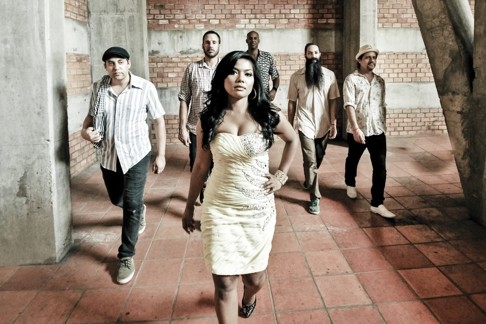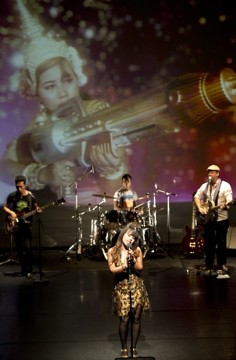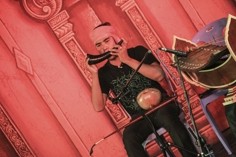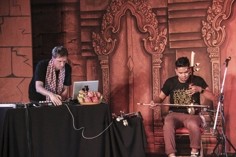
Cambodia’s psychedelic rock enters new phase, inspired by golden age of 1960s and ’70s
Cambodian culture of all kinds was almost completely destroyed by the Khmer Rouge, including a well-developed rock’n’roll scene that mixed traditional and Western sounds. But aficionados from East and West are refusing to let this beloved music disappear

An exotic blend of Cambodian rock, afro grooves, surf and psychedelic garage wafts from a romantically derelict French colonial villa sitting off the riverside in Phnom Penh. The crowd bounces in the mansion’s open courtyard to the enigmatic vocals of Khmer singer Chhom Nimol, which flutter above heavy guitar chords, roaring bass, seductive horns and the beat of drums.
The band Dengue Fever draw a big crowd when performing on the lead singer’s home turf, and this gig is no different. This is one of three February dates in Cambodia (their first shows in the country since 2013), before an extensive tour of the US in March and April, and the US-based band are representative of a musical revival movement that has swept across the kingdom and beyond.
Drawing influences from the vibrant Cambodian rock scene the country enjoyed during the “golden era” of the 1960s and ’70s, and giving it a modern spin, the American-Cambodian band are one example of how the country’s music scene is being refreshed as it enters a new, exciting chapter.

During the golden era, Phnom Penh’s popular nightspots were overflowing with young Cambodians twisting and shaking to the country’s unique spin on rock ’n’ roll.
Layering the hypnotic yodels of female Cambodian singers with gentle saxes, organs and drums, the lively Cambodian rock scene captivated the country, and fans in flared pants flocked from all over the country to hear the sounds of the likes of Ros Sereysothea, Yol Aularong and Sin Sisamuth, the artists who defined the movement.

“This era of rock ’n’ roll happened in the 1960s right up until the moment Phnom Penh fell to the Khmer Rouge. The genocidal regime literally ripped the heart and soul of the music from its socket,” says Julien Poulson, of the locally based Cambodian Space Project (CSP), a colourful musical outfit that breathes new life into the golden era. The band came together in 2009 when the Australian Poulson and Khmer singer Kak Channthy had a chance meeting in a karaoke bar.
After the Kingdom of Wonder started to rebuild itself, Khmer Rouge survivor Arn Chorn-Pond launched Cambodian Living Arts (CLA) in 1998 out of fear that the traditional arts he grew up with, which were passed from master to student, might be lost forever.
Chorn-Pond had been forced to learn the flute to play the propaganda songs that were blasted through speakers at his labour camp to drown out the screams of those being tortured. After escaping to a refugee camp on the Thai border he moved to the US, but on his return Chorn-Pond wanted to preserve and reconnect Cambodian music with the Cambodian people.
Since then, the organisation has encouraged a new wave of musicians and troupes by training and supporting performing artists in both traditional and modern art forms, helping to put the country’s burgeoning scene on the global music map.
“As Cambodia has developed and new generations of artists have emerged, CLA continues to help the growth of a vibrant, dynamic, engaging and living arts scene throughout Cambodia, where both traditional and contemporary arts can thrive,” says the organisation’s Hermione Brooks, citing locally based band Krom Monster as an example of musicians blending old with new.


Currently working on their fifth LP, CSP have played a crucial role in reviving the lost golden era and repackaging it for a new generation. Vintage rock ’n’ roll sounds are given a fresh twist with Kak’s beautifully haunting Khmer vocals, interlaced with “Khmenglish” and a little bit of French, accompanied by a mix of sounds from guest performers.
“The music of the golden era still sounds incredibly free, vibrant, liberated and fresh today,” says Poulson. “It’s full of swinging rhythms, from surf to Latin, fuzzed-out guitars, groovy electric organ, a mix of Brit Invasion and GI radio-influenced songs, but at the same time distinctly Khmer, and all this underscoring the unique voices of Khmer singers.”
Recreating these iconic sounds has also been high on Dengue Fever’s agenda. The band were born after a six-month backpacking trip in the late 1990s across Southeast Asia by keyboardist Ethan Holtzman, who returned to America with a rucksack crammed full of cassette tapes of retro Cambodian rock. In 2002, with his brother Zac, saxophonist David Ralicke, drummer Paul Smith and bassist Senon Williams, Dengue Fever was born.

As well as inspiring a new wave of musicians, the bands have also piqued international interest in the country’s music scene through their global tours. Last year’s release of the CSP documentary Not Easy Rock ’n’ Roll and a film by American director John Pirozzi titled Don’t Think I’ve Forgotten, a documentary on the Cambodian rock scene and its demise which received rave reviews after its US premier, have also given Cambodia’s modern vintage music a welcome boost.
“Despite this tragic history, their music has lived on,” says Poulson. “It’s a haunting legacy of powerful song, and has even more significance and meaning today because of the importance of rebuilding and reviving a culture that was almost extinguished. More and more bands in Cambodia are playing this music now, and today’s generation is learning about its history – as well as how infectiously cool the music itself is.”